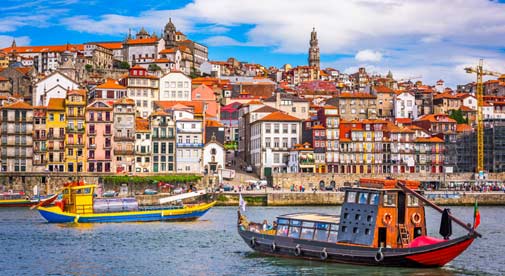There is a magical undercurrent that pervades Portugal, a sense of a carefully preserved past. Golden beaches with sparkling clean waters line the western and southern coastlines. Flower-filled meadows stretch toward sloping hills, then rise to mountain bluffs crowned by a 12th-century castle. You can picnic amid a ghostly city abandoned by the Romans, or explore the old palaces and summer retreats of royalty and hike through forests famed for poets.
And it’s the most affordable country in Western Europe—a couple can live well on less than $30,000 per year, immersed in history, culture, and eating out often.
Read on to discover seven idyllic spots in Portugal where the cost of living is low and the quality of life is high:
Setúbal

For those who dream of big city living on a small-town budget, Setúbal may be just what you are after. As part of the greater Lisbon metropolitan area, many Portuguese live in Setúbal and work in Lisbon, just a short commute by train. Pronounced sh-tu-bal by the locals, the city of 124,000 is an authentic Portuguese city that has gained popularity with expats from around the world.
The city’s main plaza is Praça do Bocage, which features a pink, yellow, black, and white tiled geometric design with a statue of a famed poet in the center. The Sado River flows through the town center, creating a peaceful spot to hang out.
The Mercado do Livromento, Portugal’s largest and most beautiful, offers the freshest seafood, fruits, vegetables, and eateries.
East of the city are the hills of the Serra da Arrábida, and the beaches of the Portinho da Arrábida. The Sado River Estuary, to the south, is where dolphins can be seen, or hop aboard a ferry and head to the Troia Peninsula, a hidden gem of beaches.
Weather averages throughout the year in Setúbal range between 45 F and 87 F, rarely dipping below 40 F or above 95 F. Winters are cool and rainy, while summers are dry and mild.
A couple can live nicely in Setúbal, including rent, utilities, basic health insurance, and other expenses for $2,400 or $28,800 a year.
Guimarães
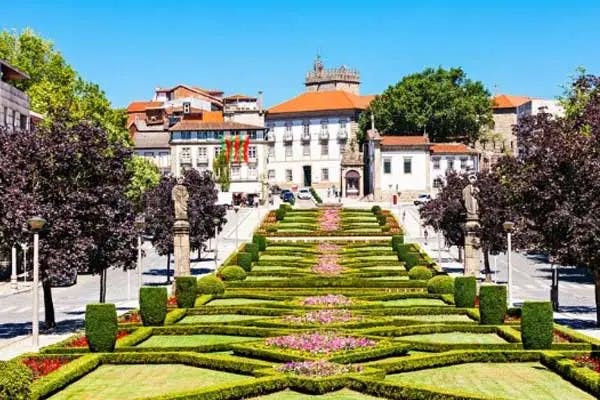
The former Roman city of Guimarães was chosen by the first king of Portugal in 1128 as his administrative base. Today it is designated a UNESCO World Heritage Site and considered Portugal’s birthplace. The city is one of the most popular day trips from Lisbon and draws tourists from around the world to visit sites like its 10th-century castle. Despite its historical attractions, the population of this very Portuguese city of 52,000 people goes on about its workaday business, creating an interesting blend in the general tone of the city.
[question_evergreen]
Guimarães is a walkable city although a bit hilly. Descending the slopes of the castle area are narrow, twisting passageways between stately granite buildings and pleasant squares like Largo da Oliveira, named for the majestic olive tree growing in its center. Every historic district in Portugal has its share of impressive convents and churches, and Guimarães is no exception. These, together with grand homes trimmed with wrought iron balconies, Gothic arches, and treasures like the Alberto Sampaio Museum offer a feast for the senses.
Summers here are short, warm, dry, and mostly sunny, while winters are chilly, wet, and partly cloudy. Over the course of the year, the average daytime temperatures typically vary from 41 F to 82 F, although extremes can make the mercury dip below 32 F or rise above 92 F.
Including rent, utilities, internet, a basic plan for private health insurance, and enjoying meals out at local eateries, a couple can live well in Guimarães for $2,300 per month or $27,600 a year.
Braga

Like so many cities in Portugal, Braga’s history was influenced by Roman occupation, and the city’s architecture and landscape vividly recall those ancient days. The magnificent Bom Jesus do Monte Sanctuary, a sacred pilgrimage site, sits perched on a hill and is accessed by a spectacular staircase or the world’s oldest water-powered funicular. Considered the oldest city in Portugal, it’s located in the north, about 20 miles east of the wind-surfing destination of Esposende.
The population of almost 200,000 is primarily Portuguese, but there’s a sprinkling of residents from Brazil, Africa, China, and Eastern European countries. The University of Minho adds diversity to the populace as well, with Erasmus students coming from all over Europe and the Far East.
That youthful influence gives a lift to an otherwise very traditional city, and many of the younger locals speak passable English. This, and the fact that many shopkeepers and restaurant owners cater to tourists, makes Braga an easy spot for expats to adopt as their own.
Braga’s climate is moderate. In summer, temperatures average around 69 F, while in winter that falls to around 47 F. December is the wettest month, with rainfall of about seven inches—similar to nearby Porto’s.
For all its richness, life in Braga is reasonably affordable. A couple can rent a two-bedroom apartment, enjoy the city’s youthful vibe, and live nicely for $2,200 per month or $26,000 a year.
[portugal_signup]
Portimão

A more affordable option in Portugal’s Algarve is this coastal gem. Originally a fishing village and ship-building center this port city of 45,000 sits where the Arade River meets the Atlantic Ocean.
Portimão, like the rest of the Algarve, is loved for its hot dry summers and mild winter temperatures with far less rain than the rest of the country. The Museu de Portimão, housed inside a 19th-century cannery gives a peek into the city’s history. It’s no surprise that grilled sardines are an easy-to-find menu item here and loved by locals and expats.
Nearby is Praia da Rocha, a picturesque beach with its ochre cliffs and clear fresh water. Ponte de Piedade, near the tourist hub of Lagos offers craggy rock formations, grottoes and adrenaline-filled boat rides for a peek inside.
Long-term rentals almost everywhere in the Algarve can be a challenge to find but with patience and time, it is possible. Since Portimão is a bit less touristy than Lagos, Tavira, or Vilamoura it may be possible to find rentals here a bit easier.
Depending on lifestyle choices a couple could live nicely in Portimão including rent, basic health insurance coverage, utilities, food, and more for around $2,500 a month or $30,000 a year.
Mafra
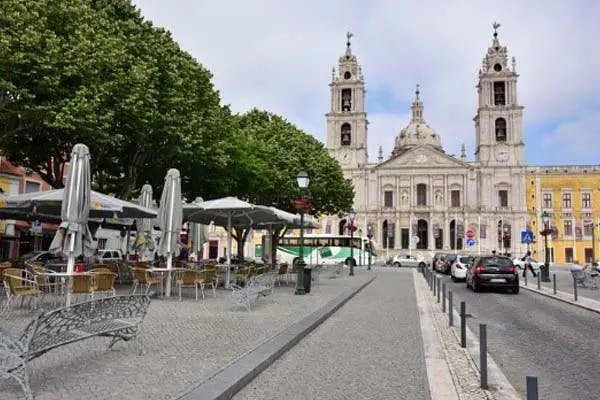
Mafra lies just 30 minutes northwest of Lisbon International Airport. A population of about 76,000 spread over 112 square miles translates to the feel of a thriving yet pleasantly-paced small city. Most of the tree-lined streets, including the main boulevard of Avenida da Liberdade, are covered with calçada Portuguesa, the traditional black-and-white Portuguese pavement. Lots of green areas dot the community, bursting with blossoms year-round.
Mafra is home to Portugal’s National Palace, built in 1717 and a royal domicile until 1910. The Palace lends its Baroque and Neo-classical charm to the city.
Summers are warm, dry, and mostly sunny in Mafra. Winter is the rainy season, and average annual temperatures range from 46 F to 80 F, with extremes being 39 F and 91 F. A couple can live well in Mafra on about $2,400 a month including rent, food, utilities and basic health insurance for $28,800 a year.
Coimbra
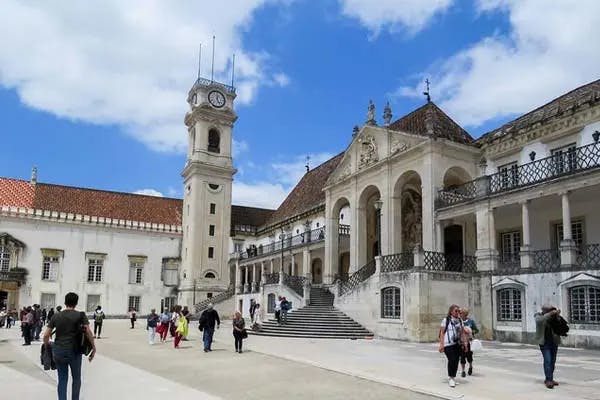
Two hours north of Lisbon lies Portugal’s former capital, Coimbra, home to one of the oldest continually operating universities in Europe. With a population of 144,000 spread over 123 square miles, Coimbra is a busy metropolis, yet it retains the mellow undertone that Portugal is famous for.
August is the hottest month in Coimbra, with an average of 73 F, and January is the coldest, averaging 51 F. January is also the wettest month, delivering about six inches of rain. For beach time in the summer months, just head west to Figueira da Foz, which has an active expat community.
Fado is the traditional music form of Portugal, and other than Lisbon, there’s no place better to hear it than Coimbra, where it is sung only by men, and where it plays a big part in university life.
Between tourism and the youthful student population, English is widely spoken in Coimbra, so being able to speak Portuguese is not a requirement for enjoying all Coimbra has to offer.
A couple can live comfortably in Coimbra for $2,400 per month, around $28,000 a year, including rent, utilities, and private health insurance.
Caldas da Rainha
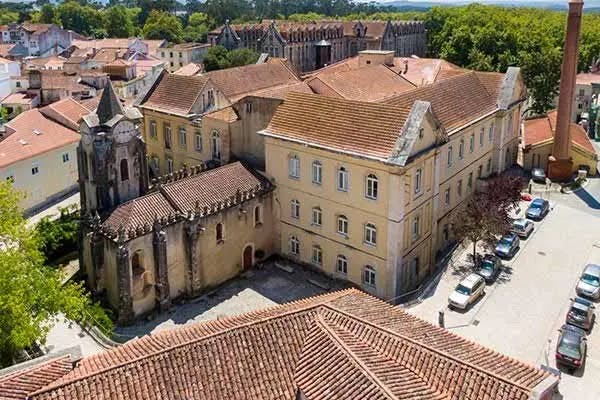
One hour north of Lisbon on Portugal’s Silver Coast sits the mid-sized city of Caldas da Rainha. Literally translated as “the Queen’s baths,” in Portuguese, it was a thermal spring discovered by Queen Leonor in the 15th century that put this city on the map. The Queen was passing through the area when she spotted some peasants bathing in foul-smelling water on the side of the road. As soon as she learned of the water’s medicinal benefit she ordered a hospital to be built around it and that hospital is still in operation today.
Parque Dom Carlos I is the perfect place to stroll through the gardens, have lunch with friends at the restaurant, or paddle a tiny boat across the duck pond. Caldas, as it’s commonly called, has a handful of museums centered around art, cycling, ceramics, and of course, the thermal hospital.
The cobbled old town hosts a daily market that sells local fruits, vegetables, and baked goods. A weekly flea market sells a bit of everything including the kitchen sink. The city has a strong ceramics culture, a skill that is still taught at the local school, and products can be bought from nearby shops.
The medieval walled city of Óbidos is just a short drive from Caldas city center and comes alive with festivals throughout the year. Tourist shops offer shots of “ginga,” a cherry-flavored liquor served in edible chocolate cups for around $1.
A large bus station makes it easy to travel from Caldas da Rainha to Lisbon, Porto, or most anywhere else in the country. The coastal area of Foz do Arelho is the perfect spot to cool off on a hot summer day. Summers on the Silver Coast are spring-like with temperatures averaging around 70 F. Winters can bring long periods of rain and cool temperatures dipping down near freezing.
Weather averages throughout the year range between 46 F and 78 F. Summers are warm and dry while winters are cold, wet, windy, and cloudy. It rarely drops below 38 F or goes above 90 F.
A couple could rent an entire villa in the country or a city center apartment rather inexpensively and lively nicely on $2,100, or $25,000 a year including private health insurance, utilities, and everyday necessities and splurges.
[portugal_signup]
Related Articles
Is Portugal a Safe Place to Live?
Portugal Itinerary: How to Spend 7 Days in Portugal
An Overview of Traditions and Culture in Portugal
[post_takeover]
[lytics_best_articles_collection]

